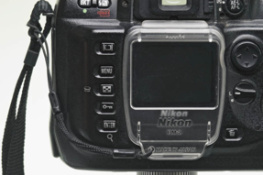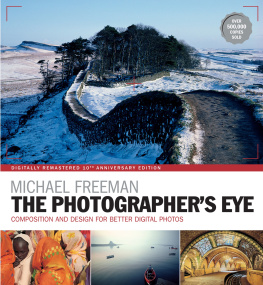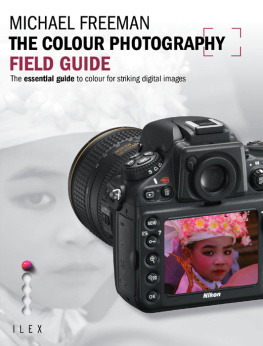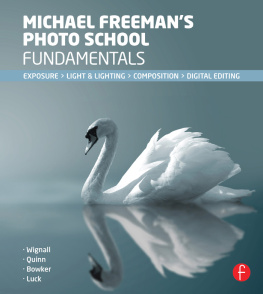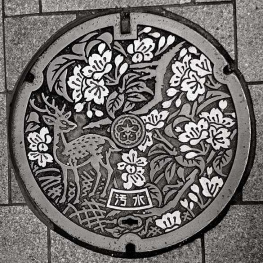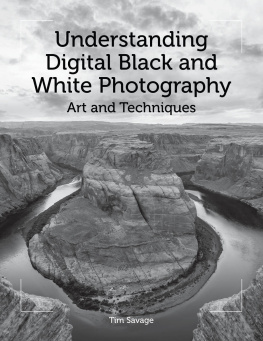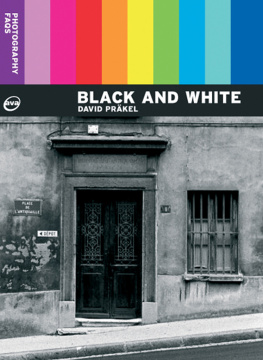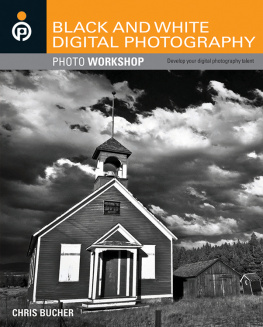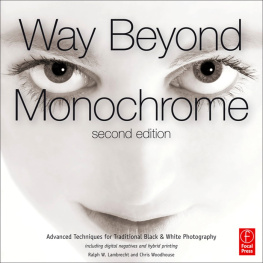Michael Freeman - Black & White Photography: The timeless art of monochrome in the post-digital age
Here you can read online Michael Freeman - Black & White Photography: The timeless art of monochrome in the post-digital age full text of the book (entire story) in english for free. Download pdf and epub, get meaning, cover and reviews about this ebook. year: 2017, publisher: Octopus, genre: Home and family. Description of the work, (preface) as well as reviews are available. Best literature library LitArk.com created for fans of good reading and offers a wide selection of genres:
Romance novel
Science fiction
Adventure
Detective
Science
History
Home and family
Prose
Art
Politics
Computer
Non-fiction
Religion
Business
Children
Humor
Choose a favorite category and find really read worthwhile books. Enjoy immersion in the world of imagination, feel the emotions of the characters or learn something new for yourself, make an fascinating discovery.

- Book:Black & White Photography: The timeless art of monochrome in the post-digital age
- Author:
- Publisher:Octopus
- Genre:
- Year:2017
- Rating:3 / 5
- Favourites:Add to favourites
- Your mark:
- 60
- 1
- 2
- 3
- 4
- 5
Black & White Photography: The timeless art of monochrome in the post-digital age: summary, description and annotation
We offer to read an annotation, description, summary or preface (depends on what the author of the book "Black & White Photography: The timeless art of monochrome in the post-digital age" wrote himself). If you haven't found the necessary information about the book — write in the comments, we will try to find it.
Black & White Photography: The timeless art of monochrome in the post-digital age — read online for free the complete book (whole text) full work
Below is the text of the book, divided by pages. System saving the place of the last page read, allows you to conveniently read the book "Black & White Photography: The timeless art of monochrome in the post-digital age" online for free, without having to search again every time where you left off. Put a bookmark, and you can go to the page where you finished reading at any time.
Font size:
Interval:
Bookmark:
MICHAEL FREEMAN
BLACK & WHITE PHOTOGRAPHY
In his long and distinguished career, photographer and author MICHAEL FREEMAN has concentrated principally on documentary travel reportage, and has been published in dozens of major publications worldwide, including Time-Life, GEO and Smithsonian magazine, for whom he has shot dozens of feature stories across the globe over the course of a three-decade relationship. Much of his work has focused on Asia, beginning in the early days with Thailand, and expanding throughout Southeast Asia, including Cambodia, Japan and China. His most recent book of documentary reportage is Tea Horse Road, tracing the ancient trade route that began in the 7th century between southwest China and Tibet.
His numerous books teaching the craft of photography have sold over four million copies, and been translated into 27 languages. The Photographers Eye is his bestselling volume, and has become the definitive work on photographic composition and design.


B lack-and-white photography occupies a unique place in the world of art and imaging, all the more surprising because within the world of photography it is taken so much for granted. What I will attempt in this book is to jolt black and white out of its normally complacent position, and in this Im helped by the completely changed circumstances of digital photography.
Why complacent? Because black and white has become so established as the senior tradition of photography over the course of more than a century that its reasons for being are only rarely questioned. For many people, perhaps most, black-and-white photography just is. I just re-read a volume on the history of photography by Ian Jeffrey, titled Photography: A Concise History that appeared in Thames & Hudsons World of Art series, where black and white is so much assumed to be centre stage that colour fills just three pages out of 240. This is by no means unusual, but it is hard to justify simply on the grounds that there were more years spent in black and white than in colour. It also wont do for the modern world of digital photography, in which the choice of one or the other is in the face of every photographer each time he or she decides to process on the computer.
It seems that most photographers, when they are shooting or processing, inhabit a world of photography alone, and only a few see their work in the wider context of art. I have to say seems because there is no way of quantifying this, but what is not in doubt is this: in the entire body of writing and discussion on photography, references to painting or any other graphic art are very thin on the ground. This is a little strange, not to say short-sighted, but its part of the reality of our photographic world. There are historical reasons for this, as there are, well, philosophical reasons.
From the other side of the fence the unconstrained art side there has been more acceptance of photography. A fairly recent phenomenon, which tends to set many photographers teeth on edge, is the appropriation of photography by artists who do not claim to be primarily photographers. In other words, contemporary artists invade photography more than photography invades art.
And it is this unmistakable sense of photography being its own world, very largely self-contained, that allows us to be complacent about black and white. Its just something that photography grew up with. Now, however, things are on the move, which is what I want to explore in this book.



D igital photography has very clearly changed the way we can shoot in black and white, and it is perfectly obvious that by far the most important practical difference between a sensor and film is that now you can have both colour and monochrome from the same shot. There is no prior choice to be made, no decision to load black-and-white film rather than colour film before setting out.
As a result, most of what is written and discussed about digital black and white focuses on the practicalities how to convert, how to adjust channels in order to alter the brightness of different colours as they appear in grayscale, how to achieve the look and grain of a favored black-and-white emulsion, and so on.
All are essential and valuable topics to study, but they skip two key issues: More fundamental than the how of shooting monochrome is why and when. Theres nothing too complicated about explaining how to achieve all the various kinds of monochrome effect from a digital image and I hasten to add that this is all included in this book but what is much more interesting is the choice to make the image in black and white rather than in the more obvious colour.
This choice transcends the difference between sensors and film, and it draws us into the long and rich tradition of black-and-white photography. Film and earlier processes, of course, weigh heavily on this tradition, and for this reason I make no apology for looking at the past. Black-and-white film photography, its image qualities and processes, have a great deal to teach us. Not only this, but black-and-white photography is traditionally more strongly associated with art than colour photography, and there are also lessons to learn from monochrome painting. The common theme running through all of this is restricting the palette. What sets black and white apart from colour is that it is not the way we see the world, and it does not pretend to represent reality. It is a translation of a view into a special medium with very particular characteristics. As we will see, there has been a changing perception of black and white as a medium in photography. Crudely put, it began as necessity, then became accepted as normal, and now, with the full choice of colour (and any kind of colour) coupled with the infinite processing possibilities of digital images, it is a creative choice.
I f by some fluke of science, photography had started with full colour, would black and white ever have evolved? Apart from needing some alternative history, I think its a reasonable question to ask, given the changes in fortune of monochrome over the years. Theres an irony in the fact that most photographers and publishers over decades wanted colour but had to put up with black and white, yet once it became practically available, first with Kodachrome and then with a slew of competitors like Fujichrome, the move to reject it began almost immediately. Certainly there were different players taking different positions, but by no means has the technology of film, and later sensors, controlled the fate of these two different photo media. It hasnt all been about what the camera can and cannot do.
Next pageFont size:
Interval:
Bookmark:
Similar books «Black & White Photography: The timeless art of monochrome in the post-digital age»
Look at similar books to Black & White Photography: The timeless art of monochrome in the post-digital age. We have selected literature similar in name and meaning in the hope of providing readers with more options to find new, interesting, not yet read works.
Discussion, reviews of the book Black & White Photography: The timeless art of monochrome in the post-digital age and just readers' own opinions. Leave your comments, write what you think about the work, its meaning or the main characters. Specify what exactly you liked and what you didn't like, and why you think so.


